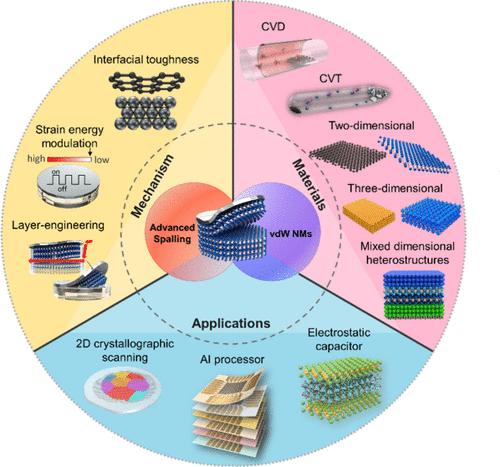当前位置:
X-MOL 学术
›
Acc. Chem. Res.
›
论文详情
Our official English website, www.x-mol.net, welcomes your
feedback! (Note: you will need to create a separate account there.)
Atomic Spalling of a van der Waals Nanomembrane
Accounts of Chemical Research ( IF 16.4 ) Pub Date : 2024-09-12 , DOI: 10.1021/acs.accounts.4c00425 Ji-Yun Moon 1 , Sang-Hoon Bae 1, 2 , Jae-Hyun Lee 3, 4
Accounts of Chemical Research ( IF 16.4 ) Pub Date : 2024-09-12 , DOI: 10.1021/acs.accounts.4c00425 Ji-Yun Moon 1 , Sang-Hoon Bae 1, 2 , Jae-Hyun Lee 3, 4
Affiliation

|
The vertical integration of van der Waals nanomembranes (vdW NMs), composed of two-dimensional (2D) layered materials and three-dimensional (3D) freestanding films with vdW surfaces, opens new avenues for exploring novel physical phenomena and offers a promising pathway for prototyping ultrathin, superior-performance electronic and optoelectronic applications with unique functionalities. Achieving the desired functionality through vdW integration necessitates the production of high-quality individual vdW NMs, which is a fundamental prerequisite. A profound understanding of the synthetic strategies for vdW NMs, along with their fundamental working principles, is crucial in guiding the experimental design toward 3D integrated heterostructures. The foremost synthetic challenges in fabricating high-quality vdW NMs are achieving exact control over thickness and ensuring surface planarity on the atomic scale. Despite the development of numerous chemical and mechanical approaches to tackle these issues, an all-encompassing solution has yet to be realized. To address these challenges, we have developed advanced spalling techniques, specifically known as atomic spalling or 2D material-based layer transfer, which emerge as a promising technology for achieving both atomically precise thickness-engineered and atomically smooth vdW NMs. These techniques involve engineering the interfacial fracture toughness and strain energy in the vdW system, allowing for precise control over the initiation and the propagation of cracks within the vdW material based on controlled spalling theory.
中文翻译:

范德华纳米膜的原子剥落
范德华纳米膜(vdW NM)由二维(2D)层状材料和具有 vdW 表面的三维(3D)独立薄膜组成,其垂直集成为探索新颖的物理现象开辟了新途径,并为研究提供了一条有前途的途径。制作具有独特功能的超薄、高性能电子和光电应用原型。通过 vdW 集成实现所需的功能需要生产高质量的单独 vdW NM,这是一个基本先决条件。深刻理解 vdW NM 的合成策略及其基本工作原理,对于指导 3D 集成异质结构的实验设计至关重要。制造高质量 vdW 纳米材料面临的最重要的综合挑战是实现厚度的精确控制并确保原子尺度的表面平坦度。尽管开发了许多化学和机械方法来解决这些问题,但尚未实现包罗万象的解决方案。为了应对这些挑战,我们开发了先进的剥落技术,特别是原子剥落或基于二维材料的层转移,该技术成为实现原子级精确厚度工程和原子级光滑 vdW NM 的有前途的技术。这些技术涉及对 vdW 系统中的界面断裂韧性和应变能进行设计,从而能够根据受控剥落理论精确控制 vdW 材料内裂纹的萌生和扩展。
更新日期:2024-09-12
中文翻译:

范德华纳米膜的原子剥落
范德华纳米膜(vdW NM)由二维(2D)层状材料和具有 vdW 表面的三维(3D)独立薄膜组成,其垂直集成为探索新颖的物理现象开辟了新途径,并为研究提供了一条有前途的途径。制作具有独特功能的超薄、高性能电子和光电应用原型。通过 vdW 集成实现所需的功能需要生产高质量的单独 vdW NM,这是一个基本先决条件。深刻理解 vdW NM 的合成策略及其基本工作原理,对于指导 3D 集成异质结构的实验设计至关重要。制造高质量 vdW 纳米材料面临的最重要的综合挑战是实现厚度的精确控制并确保原子尺度的表面平坦度。尽管开发了许多化学和机械方法来解决这些问题,但尚未实现包罗万象的解决方案。为了应对这些挑战,我们开发了先进的剥落技术,特别是原子剥落或基于二维材料的层转移,该技术成为实现原子级精确厚度工程和原子级光滑 vdW NM 的有前途的技术。这些技术涉及对 vdW 系统中的界面断裂韧性和应变能进行设计,从而能够根据受控剥落理论精确控制 vdW 材料内裂纹的萌生和扩展。































 京公网安备 11010802027423号
京公网安备 11010802027423号